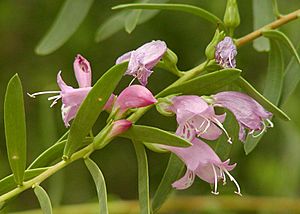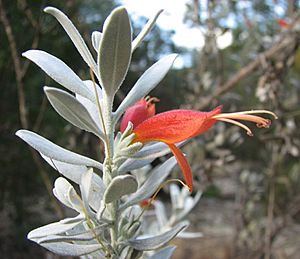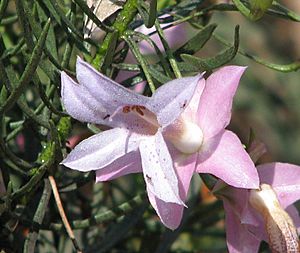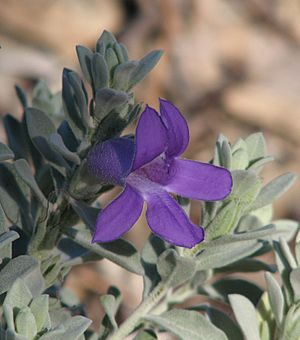Eremophila (plant) facts for kids
Eremophila is a group of over 260 types of plants, mostly found only in Australia. These plants are part of the figwort family. One type, Eremophila debilis, is also found in New Zealand, but it probably arrived there recently.
Eremophilas grow in dry parts of Australia, especially in Western Australia. They can be small, low-growing shrubs or even small trees. Their flowers have petals joined together, forming a tube. The top petals often look different from the bottom ones.
Some common names for these plants are emu bush, poverty bush, or fuchsia bush. People call them emu bush because emus eat their fruit. Poverty bush refers to the dry, poor soil where they often grow. Fuchsia bush is because their flowers look a bit like those of the Fuchsia plant.
Quick facts for kids Eremophila |
|
|---|---|
 |
|
| E. maculata (cultivated) at Desert Demonstration Garden in Las Vegas | |
| Scientific classification |
|
| Kingdom: | Plantae |
| Clade: | Tracheophytes |
| Clade: | Angiosperms |
| Clade: | Eudicots |
| Clade: | Asterids |
| Order: | Lamiales |
| Family: | Scrophulariaceae |
| Tribe: | Myoporeae |
| Genus: | Eremophila R.Br. |
| Species | |
| Synonyms | |

Contents
What Eremophilas Look Like
Eremophila plants come in many different sizes and shapes. Some are low, spreading shrubs like E. serpens. Others are small trees, such as E. bignoniiflora.
Their leaves also vary in size and shape. They are usually small and can be shiny or covered in tiny hairs.
Flower Colors and Shapes
Eremophila flowers typically have five spreading sepals and five petals. The petals are joined together, at least at their base, to form a tube. The most common flower colors are red, purple, lilac, and mauve. You can also find white and even green flowers. Many types have flowers with a mix of colors, or they might have spots or streaks. Sometimes only the petals are colorful, but often the sepals are bright too.
Flower shapes can differ. Most have two petals at the top of the tube and three at the bottom. The stamens (the parts that hold pollen) are inside the tube, like in E. exilifolia. These flowers are usually pollinated by insects. The lower petals act like a landing pad for them.
Other types have four petal lobes at the top and one below that curls under the flower. Their stamens stick out beyond the petal tube, as seen in E. glabra. These flowers are usually pollinated by birds. The bird holds onto the plant stem while it sips nectar from the flower. A few species have flowers that are a mix of these two shapes.
Fruits and Seeds
After a flower gets older, its petals fall off. Then, the calyx (the outer leaf-like parts of the flower) gets bigger and changes color as the fruit grows. The fruits hold between 2 and 12 seeds. These seeds can stay in the ground for many years. They often only sprout after a fire, heavy rain, or even human activities like road building.
Some eremophila species, like E. sturtii, can spread by sending up new shoots from their roots. This has made them a problem in some areas. However, many more species are rare or in danger because of human activities like clearing land, farming, and mining.
Naming Eremophila Plants
The group of plants called Eremophila was first officially described in 1810 by a botanist named Robert Brown. He wrote about them in his book Prodromus Florae Novae Hollandiae. The first two species he named were E. oppositifolia and E. alternifolia.
Later, Ferdinand von Mueller, a government botanist from Victoria, became very interested in these plants. He described 47 new species. Today, Robert Chinnock is a leading expert who has named over 100 species of eremophilas. Many more are still being discovered and need to be named because they grow in very remote places. So far, 221 species have been described, but about 40 more have been found but not yet officially named. The newest ones described in 2016 were Eremophila buirchellii and Eremophila calcicola.
The name Eremophila comes from two Ancient Greek words: erêmos, meaning "lonely" or "desert," and phílos, meaning "dear" or "beloved." This name shows how these plants are well-suited to living in dry, desert areas.
Common Names of Eremophilas
Many eremophila species have common names that include "emu bush" or "poverty bush." Sometimes, two different species might share the same common name, or one species might have several different names. Here are some examples of eremophila species and their common names:
- E. alternifolia – narrow-leaved emu bush
- E. bignoniiflora – gooramurra, bignonia emu bush
- E. compacta – compact emu bush
- E. divaricata – spreading emu bush
- E. elderi – aromatic emu bush
- E. gilesii – Charleville turkey bush, green turkey bush, Giles emu bush
- E. glabra – common emu bush
- E. glutinosa – sticky emu bush
- E. hillii – Hill's emu bush
- E. lactea – milky emu bush
- E. maculata – spotted emu bush
- E. polyclada – twiggy emu-bush
- E. scaberula – rough emu bush
- E. scoparia – silver emu bush, broom bush
- E. abietina – spotted poverty bush
- E. anomala – Paroo poverty bush
- E. attenuata – Connie Sue poverty bush
- E. aureivisca – Rason poverty bush
- E. battii – Batt's poverty bush
- E. bowmanii – Bowman's poverty bush
- E. campanulata – bell-flowered poverty bush
- E. ciliata – Archer's poverty bush
- E. denticulata – toothed poverty bush
- E. foliosissima – poverty bush
- E. granitica – granite poverty bush, thin-leaved poverty bush
- E. maitlandii – Shark Bay poverty bush
- E. malacoides – frontage poverty bush
- E. margarethae – sandbank poverty bush
- E. metallicorum – miners poverty bush
- E. micrantha – small-flowered poverty bush
- E. parvifolia – small-leaved poverty bush
- E. pterocarpa – wing-fruited eremophila, silver poverty bush
- E. spectabilis – showy poverty bush
- E. spinescens – spiny poverty bush
Where Eremophilas Grow
Eremophilas are found all over mainland Australia, mostly in dry areas. Most species grow in Western Australia. For example, Eremophila maculata can be found in every Australian state. However, no eremophilas grow in Tasmania. As mentioned, Eremophila debilis is also in New Zealand, likely brought there by people.
In Western Australia, at least 229 species exist. About 80% of these are found only in that state. They are very common in dry regions. In the Meekatharra-Wiluna area, there are over 50 different eremophila species. They are often the most common shrubs you will see there. A few species, like E. complanata and E. mirabilis, grow in very specific spots, sometimes only on one or two rocky hills.
How Eremophilas Interact with Nature
Eremophila plants have different ways to attract pollinators. Some species have flowers that attract insects. These flowers often have a lower lip that sticks out, giving insects a place to land. They are usually blue, purple, or white.
Other species have flowers that attract birds. These flowers are typically red, orange, yellow, or green. Their petals point downwards, which makes it harder for insects to land. Bird-pollinated flowers also tend to have longer stamens. When a bird feeds, these stamens brush pollen onto and off the bird's head.
The fruits of eremophilas are eaten by emus. The emus then help to spread the seeds in their droppings. However, it's a myth that this helps the seeds sprout better.
Some eremophila species, like E.freelingii and E.latrobei, can be harmful to farm animals if eaten. But others, such as E.bignoniiflora and E.oppositifolia, are good plants for animals to eat.
How People Use Eremophilas
Traditional Uses
Aboriginal people have used eremophilas for important cultural and health reasons. For example, the Adnyamathanha people used a plant called Varti-varka (Eremophila longifolia) in their burial and initiation ceremonies. They also treated skin problems by mixing emu oil with ash from the burned bark of the plant.
Growing Eremophilas in Gardens
In the past, eremophilas were not often grown in gardens. This was partly because they were hard to grow from seeds or cuttings. Also, many types were rarely seen, even in nature. However, as people have learned better ways to grow them, eremophilas have become more popular.
Their beautiful and plentiful flowers, varied leaves, and long flowering times make them great garden plants. Most are good at handling dry weather, and many can also survive frost. This means they can grow in many different places.
It can be tricky to grow them from seeds or even from cuttings. But most species can be grafted onto the roots of Myoporum plants. This is a big advantage because it allows them to grow in almost any type of soil, even heavy clay. Some good Myoporum types for grafting include Myoporum insulare, M. montanum, and M. acuminatum. While it is possible to get eremophila seeds to sprout, it often means leaving the fruit in the ground for a long time or carefully taking the seed out without hurting it.
In nature, most eremophilas grow where it doesn't rain often. They are very good at surviving long dry periods, even droughts that last for years. Because of this, eremophilas are perfect for gardens that don't need a lot of care or water. In fact, giving too much water can actually kill many species. During a very dry spell, some species, like E. microtheca, might lose their leaves and look dead. But after a good watering, they can recover and become healthy, bushy plants again. Most eremophilas also grow well in poor soil, so they rarely need fertilizer.
See also
 In Spanish: Eremophila para niños
In Spanish: Eremophila para niños





